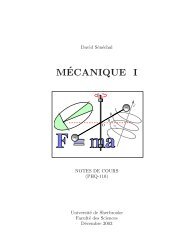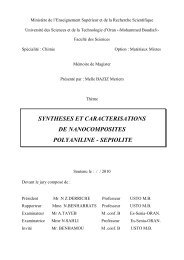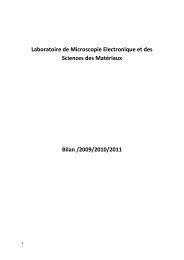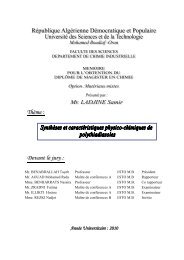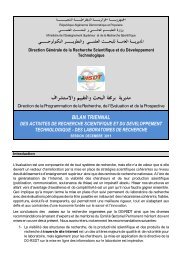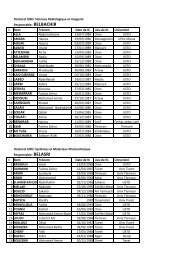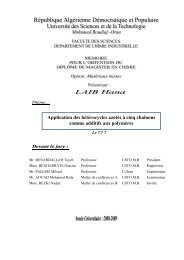Le livre des resumes - Université des Sciences et de la Technologie ...
Le livre des resumes - Université des Sciences et de la Technologie ...
Le livre des resumes - Université des Sciences et de la Technologie ...
You also want an ePaper? Increase the reach of your titles
YUMPU automatically turns print PDFs into web optimized ePapers that Google loves.
STOP FEU, Oran 2010 Posters Thème I<br />
P.1.6<br />
Active Fire Monitoring with SEVIRI MSG Satellites<br />
A.Hassini ab , A.H.Belbachir a<br />
a Laboratory of Application and Analysis of Radiations LAAR,<br />
Department of Physics USTOMB. El M’nouer B.P.1505 Oran, Algeria.<br />
Tel: +213 74374379; Fax: +213 41560350 Email: ab<strong>de</strong><strong>la</strong>tif_hassini@yahoo.com<br />
The first of the new generation of M<strong>et</strong>eosat satellites, known as M<strong>et</strong>eosat Second<br />
Generation (MSG-1), was <strong>la</strong>unched in August 2002. As with the current M<strong>et</strong>eosat<br />
series, MSG is spin-stabilized, and capable of greatly enhanced Earth observations.<br />
The satellite’s 12-channel imager, known formally as the Spinning Enhanced Visible<br />
and Infrared Imager (SEVIRI), observes the full disk of the Earth with an<br />
unprece<strong>de</strong>nted repeat cycle of 15 minutes in 12 spectral wavelength regions or<br />
channels.<br />
Our goal is to collect maximum MSG images data with our real time acquisition<br />
system, to trust the continuous observation of the Earth’s full disk with a multi-spectral<br />
imager.<br />
This paper gives an overview of the MSG SEVIRI instrument, the general approach<br />
for the active fire monitoring, and the <strong><strong>de</strong>s</strong>cription of the algorithm tog<strong>et</strong>her with the<br />
practical application of the tests and the algorithm.<br />
The AFMA algorithm (Active Fire Monitoring Algorithm) <strong>de</strong>veloped in this work is<br />
able to d<strong>et</strong>ect most of the existing active fires with a minimum of false a<strong>la</strong>rms.<br />
The AFMA algorithm distinguishes b<strong>et</strong>ween Diurnal and Nocturnal periods of day.<br />
The algorithm itself is based on a simple threshold algorithm. A few results are<br />
<strong><strong>de</strong>s</strong>cribed and discussed.<br />
Keywords: Satellite images, SEVIRI, MSG, Fires, AFMA algorithm.<br />
Somme results:<br />
Receivi<br />
KU<br />
EUMETSA<br />
TUSBK<br />
PCI-<br />
Co<br />
Figure 1. Global synoptic of MSG acquisition system.<br />
Figure 2. AFMA algorithm: Pixel to be c<strong>la</strong>ssified<br />
as a diurnal fire pixel.<br />
T4 > threshold1<br />
SDev4 > threshold2<br />
T4-T9 > threshold3<br />
SDev9< threshold4<br />
Diurnal fire<br />
55



